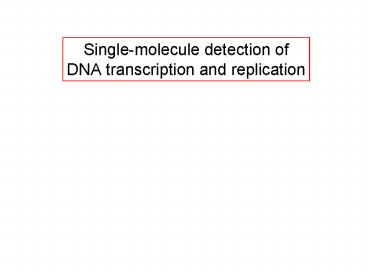Singlemolecule detection of DNA transcription and replication - PowerPoint PPT Presentation
Title:
Singlemolecule detection of DNA transcription and replication
Description:
2. No promoter unwinding is observed in the absence of the initiation factor s; ... 4. Unwinding is abolished by prior addition of heparin (binds free RNAP) ... – PowerPoint PPT presentation
Number of Views:41
Avg rating:3.0/5.0
Title: Singlemolecule detection of DNA transcription and replication
1
Single-molecule detection ofDNA transcription
and replication
2
Transcription initiation by RNA polymerase
3
Topology of promoter unwinding
Lk Tw Wr const
DTw -1
4
Observation of promoter unwinding by bacterial
RNA polymerase
Positively supercoiled DNA
Negatively supercoiled DNA
Promoter unwinds
Promoter unwinds
DNA extension decreases
DNA extension increases
5
Calibration of DNA supercoiling
In linear regime (II) dl 56 nm/turn
plectoneme
6
Direct observation of promoter unwinding
consensus lac promoter
Dlobs,-
Dlobs,
7
Positively supercoiled DNA containing three
lac(cons) promoters in tandem ? three bubbles
8
More Control Experiments
1. No unwinding is observed with a DNA
template having no promoter
2. No promoter unwinding is observed in the
absence of the initiation factor s
3. No unwinding is observed at temperatures
below 23 C
4. Unwinding is abolished by prior addition of
heparin (binds free RNAP)
9
Analysis of transition amplitudes (Dlobs- ,
Dlobs)
Dlobs,- 50 nm
Dlobs, 80 nm
Why is the transition amplitude greater for
positively supercoiled DNA ??
10
what if RNAP bends the promoter DNA?
A bend will always lead to a decrease e in DNA
extension
Dlobs observed signal Dlu signal to due
unwinding e signal due to bending
Dlu 65 nm ? unwinding 13 bp e 15 nm ? bend
110o
11
Waiting times lifetimes obey
single-exponential statistics
Time-intervals between formation of open complex
Lifetime of open complex
12
Concentration-dependence of rate of formation
and dissociation of open promoter complex
Twait
Tunwound
- Lifetime Tunwound 1/kr is concentration-independ
ent
- Waiting time Twait 1/kf depends linearly on
inverse concentration (TAU plot)
13
What does concentration-dependence tell us?
RNAP
PROMOTER
KB 100 nM-1
RNAP
PROMOTER
Kf 0.3 s-1
RNAP
Kr 0.025 s-1
RNAP
14
Temperature-dependence in agreement with bulk
results
23C
25C
28C
34C
15
Effects of promoter sequenceunwinding at the
rrnB P1 promoter
16
Supercoiling-dependence of promoter unwinding
lac(cons)
rrnB P1
Positive supercoiling slows down formation of
o.c. and destabilizes o.c.
Equilibrium shifts 15-fold for an increase in
supercoiling density of 0.007
Negative supercoiling stabilizes o.c.
A supercoiling-dependent regime is followed by a
supercoiling-independent regime
17
Formation of open-promoter complex is highly
sensitive to DNA torque
Torque increases by about 0.2 pN nm/turn for
data in regime (I) and saturates at about 5 pN nm.
18
Does torque saturate in vivo?
Extended Single molecule
In vivo circular plasmid
- Constant force
- Extension varies with s
- A critical torque must be reached for supercoils
to form. - Torque begins to saturate as supercoils form
(Gdenat5 pN nm)
- Constant extension (zero)
- Force varies with s
- Supercoils form early
- Torque increases with supercoiling
- Torque saturates when DNA denatures
- (sdenat -0.06, Gdenat8 pN nm)
19
Effect of inhibitor nucleotide ppGppon lifetime
of open promoter complex
A 3-fold destabilization (from 30s to 10s) of
open-promoter lifetime is observed at both
promoters upon addition of 100 mM ppGpp.
20
2 mM initiating nucleotides stabilizes open
promoter (lacCONS)
no NTP
ATP
UTP
CTP
GTP
21
2 mM initiating nucleotide stabilizes open
promoter (rrnB P1)
22
Observation of promoter clearance rationale
positively supercoiled template
23
Transcription observed with all 4 nucleotides
(I) control experiment (sc lac promoter)
24
Transcription observed with all 4 nucleotides (II)
25
OT measurements of elongation rate
Wang et al., Nature (1998) 282 902-907
26
Rates are (essentially) independent of force
Wang et al., Nature (1998) 282 902-907
27
High Stall forces are observed
Wang et al., Nature (1998) 282 902-907
28
RNA Polymerase tracks the DNA axis
Harada et al., Nature (2001) 409 113-115
29
DNA Polymerases
Processivity low in the absence of processivity
factors ? need a different scheme
Maier et al., PNAS (2000) 97 12002-12007
30
DNAp converts ssDNA to (stiffer) dsDNA
Maier et al., PNAS (2000) 97 12002-12007
31
DNA replication rate is force-dependent
Maier et al., PNAS (2000) 97 12002-12007
32
Force-dependence results (cont)
Maier et al., PNAS (2000) 97 12002-12007
33
Observation of T7 DNAp exonuclease activity
Wuite et al., Nature (2000) 404 103-106
34
Acknowledgements
Rutgers Univ. A. Revyakin R.H. Ebright
Research on transcription initiation funded by
the Cold Spring Harbor Fellows program































